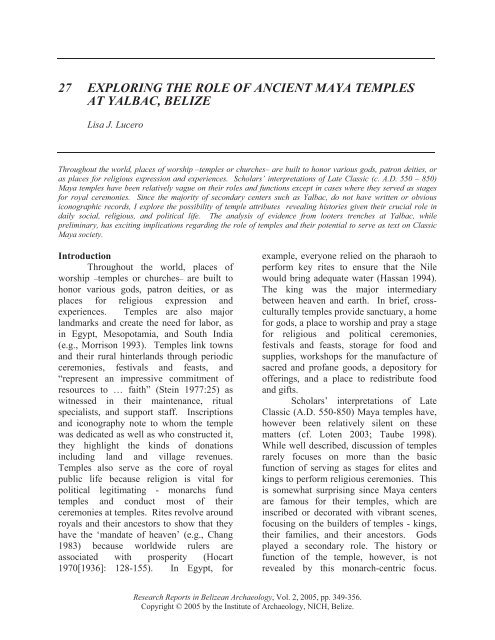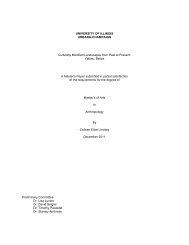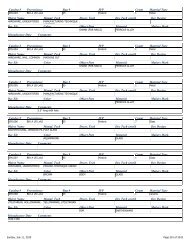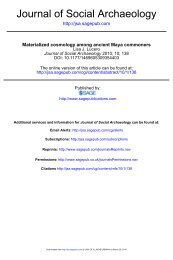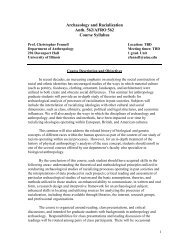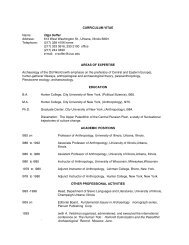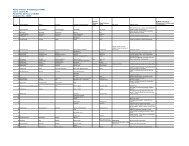2005 Exploring the Roles of Temples at Yalbac. Research Reports ...
2005 Exploring the Roles of Temples at Yalbac. Research Reports ...
2005 Exploring the Roles of Temples at Yalbac. Research Reports ...
You also want an ePaper? Increase the reach of your titles
YUMPU automatically turns print PDFs into web optimized ePapers that Google loves.
27 EXPLORING THE ROLE OF ANCIENT MAYA TEMPLESAT YALBAC, BELIZELisa J. LuceroThroughout <strong>the</strong> world, places <strong>of</strong> worship –temples or churches– are built to honor various gods, p<strong>at</strong>ron deities, oras places for religious expression and experiences. Scholars’ interpret<strong>at</strong>ions <strong>of</strong> L<strong>at</strong>e Classic (c. A.D. 550 – 850)Maya temples have been rel<strong>at</strong>ively vague on <strong>the</strong>ir roles and functions except in cases where <strong>the</strong>y served as stagesfor royal ceremonies. Since <strong>the</strong> majority <strong>of</strong> secondary centers such as <strong>Yalbac</strong>, do not have written or obviousiconographic records, I explore <strong>the</strong> possibility <strong>of</strong> temple <strong>at</strong>tributes revealing histories given <strong>the</strong>ir crucial role indaily social, religious, and political life. The analysis <strong>of</strong> evidence from looters trenches <strong>at</strong> <strong>Yalbac</strong>, whilepreliminary, has exciting implic<strong>at</strong>ions regarding <strong>the</strong> role <strong>of</strong> temples and <strong>the</strong>ir potential to serve as text on ClassicMaya society.IntroductionThroughout <strong>the</strong> world, places <strong>of</strong>worship –temples or churches– are built tohonor various gods, p<strong>at</strong>ron deities, or asplaces for religious expression andexperiences. <strong>Temples</strong> are also majorlandmarks and cre<strong>at</strong>e <strong>the</strong> need for labor, asin Egypt, Mesopotamia, and South India(e.g., Morrison 1993). <strong>Temples</strong> link townsand <strong>the</strong>ir rural hinterlands through periodicceremonies, festivals and feasts, and“represent an impressive commitment <strong>of</strong>resources to … faith” (Stein 1977:25) aswitnessed in <strong>the</strong>ir maintenance, ritualspecialists, and support staff. Inscriptionsand iconography note to whom <strong>the</strong> templewas dedic<strong>at</strong>ed as well as who constructed it,<strong>the</strong>y highlight <strong>the</strong> kinds <strong>of</strong> don<strong>at</strong>ionsincluding land and village revenues.<strong>Temples</strong> also serve as <strong>the</strong> core <strong>of</strong> royalpublic life because religion is vital forpolitical legitim<strong>at</strong>ing - monarchs fundtemples and conduct most <strong>of</strong> <strong>the</strong>irceremonies <strong>at</strong> temples. Rites revolve aroundroyals and <strong>the</strong>ir ancestors to show th<strong>at</strong> <strong>the</strong>yhave <strong>the</strong> ‘mand<strong>at</strong>e <strong>of</strong> heaven’ (e.g., Chang1983) because worldwide rulers areassoci<strong>at</strong>ed with prosperity (Hocart1970[1936]: 128-155). In Egypt, forexample, everyone relied on <strong>the</strong> pharaoh toperform key rites to ensure th<strong>at</strong> <strong>the</strong> Nilewould bring adequ<strong>at</strong>e w<strong>at</strong>er (Hassan 1994).The king was <strong>the</strong> major intermediarybetween heaven and earth. In brief, crossculturallytemples provide sanctuary, a homefor gods, a place to worship and pray a stagefor religious and political ceremonies,festivals and feasts, storage for food andsupplies, workshops for <strong>the</strong> manufacture <strong>of</strong>sacred and pr<strong>of</strong>ane goods, a depository for<strong>of</strong>ferings, and a place to redistribute foodand gifts.Scholars’ interpret<strong>at</strong>ions <strong>of</strong> L<strong>at</strong>eClassic (A.D. 550-850) Maya temples have,however been rel<strong>at</strong>ively silent on <strong>the</strong>sem<strong>at</strong>ters (cf. Loten 2003; Taube 1998).While well described, discussion <strong>of</strong> templesrarely focuses on more than <strong>the</strong> basicfunction <strong>of</strong> serving as stages for elites andkings to perform religious ceremonies. Thisis somewh<strong>at</strong> surprising since Maya centersare famous for <strong>the</strong>ir temples, which areinscribed or decor<strong>at</strong>ed with vibrant scenes,focusing on <strong>the</strong> builders <strong>of</strong> temples - kings,<strong>the</strong>ir families, and <strong>the</strong>ir ancestors. Godsplayed a secondary role. The history orfunction <strong>of</strong> <strong>the</strong> temple, however, is notrevealed by this monarch-centric focus.<strong>Research</strong> <strong>Reports</strong> in Belizean Archaeology, Vol. 2, <strong>2005</strong>, pp. 349-356.Copyright © <strong>2005</strong> by <strong>the</strong> Institute <strong>of</strong> Archaeology, NICH, Belize.
<strong>Exploring</strong> <strong>the</strong> Role <strong>Yalbac</strong> <strong>Temples</strong>Were all Maya temples built <strong>the</strong> same, or dotemples show variability? In ei<strong>the</strong>r case, did<strong>the</strong>y serve varied functions? Were templesbuilt for different gods, or did <strong>the</strong>y all havesimilar functions? Were <strong>the</strong>y funded bydifferent groups <strong>of</strong> people, not just kings?Different groups could include wealthyfamilies or elites, lesser royals or nobles, oreven community members. The fundamentalquestion is: Why did <strong>the</strong> Maya build somany temples? Before we can address <strong>the</strong>sequestions, we need more concreteinform<strong>at</strong>ion about temple histories. In thispaper, I present preliminary d<strong>at</strong>a fromtemple looters trenches <strong>at</strong> <strong>Yalbac</strong> th<strong>at</strong> showpromising results regarding variability.Since <strong>the</strong> majority <strong>of</strong> secondary centerslike <strong>Yalbac</strong> do not have written records, Iexplore whe<strong>the</strong>r or not temple <strong>at</strong>tributes canreveal histories indic<strong>at</strong>ing th<strong>at</strong> temples werecrucial in daily social, religious, andpolitical life. Attributes explored includefrequency <strong>of</strong> temples within centers, sizedifferences, loc<strong>at</strong>ion with regard to o<strong>the</strong>rmonumental architecture, layout andaccessibility (priv<strong>at</strong>e or restricted), history<strong>of</strong> use, and construction p<strong>at</strong>terns includingstyle, labor, m<strong>at</strong>erials, decor<strong>at</strong>ive fe<strong>at</strong>ures,and ritual deposits.<strong>Yalbac</strong><strong>Yalbac</strong> site is loc<strong>at</strong>ed under junglecanopy, near pockets <strong>of</strong> good agriculturalland, along <strong>Yalbac</strong> Creek, a perennialstream, on <strong>the</strong> eastern border <strong>of</strong> <strong>the</strong> sou<strong>the</strong>rnlowlands (Graebner 2002a, 2002b; Lucero2004; Lucero et al. 2004). J. Eric Thompsonmade brief mention <strong>of</strong> an eastern group <strong>of</strong><strong>Yalbac</strong> in <strong>the</strong> 1930’s (1939:2, 282), butappeared to have inadvertently missed <strong>the</strong>site core (Figure 1). Plaza test pits yieldedceramics d<strong>at</strong>ing from c. 300 B.C. throughA.D. 900, or <strong>the</strong> L<strong>at</strong>e Preclassic through <strong>the</strong>Terminal Classic period.The six pyramid temples <strong>at</strong> <strong>Yalbac</strong>range from 8 to 16m in height <strong>of</strong> which fiveexhibited looters trenches (LTs). Thelooters trenches were recorded in pr<strong>of</strong>ilesduring <strong>the</strong> 2002-2004 seasons and yieldedimportant clues as to constructionsequences. At present, <strong>the</strong> temples allappear to lack summit structures and plasterfloors; some have cut-stone terraced facadesand dry and mortared boulder and cobblecore fill. Surface ceramics indic<strong>at</strong>e <strong>the</strong>temples were used through <strong>the</strong> L<strong>at</strong>e Classicperiod (A.D. 550-850), even though <strong>the</strong>Maya began building some much earlier in<strong>the</strong> L<strong>at</strong>e Preclassic (300-100 B.C.) (e.g.Plaza 3 temples).All temples are loc<strong>at</strong>ed on large openplazas, though Plaza 3 is slightly morerestricted than Plaza 2. These two plazascontain <strong>the</strong> two tallest temples, Str. 2A (40 x36 m, 16 m tall) and Str. 3A (45 x 25 m, 11m tall), and Plaza 2 has <strong>the</strong> only ballcourt.Interestingly, <strong>the</strong> western structure <strong>of</strong> <strong>the</strong>ballcourt is <strong>at</strong>tached to <strong>the</strong> front <strong>of</strong> <strong>the</strong>temple ra<strong>the</strong>r than <strong>at</strong> <strong>the</strong> back as one finds <strong>at</strong>Xunantunich and Cahal Pech; ei<strong>the</strong>r <strong>the</strong>Maya no longer used <strong>the</strong> temple or moved<strong>the</strong> staircase to <strong>the</strong> side, or <strong>the</strong>y built <strong>the</strong>temple after <strong>the</strong> ballcourt, perhaps to enclose<strong>the</strong> plaza (John Morris, pers. comm., 2004).Str. 3A and Str. 3D (45 x 25, 8 m tall) are<strong>the</strong> only temples with wings on <strong>the</strong> northand south sides, which likely contain tombs(Jaime Awe, pers. comm. 2004).Plaza 2 temples are on averagebigger than Plaza 3 temples (15,960 cm 3 vs.7,792 cm 3 ). Plaza 2 temples have morefaced stones on average (19% vs. 12%) andare thrice <strong>the</strong> average size <strong>of</strong> <strong>the</strong> Plaza 3temples (1,318 cm 2 vs. 435 cm 2 ). Shapedstone blocks are faced on all exposed sides,especially on <strong>the</strong> front sides <strong>of</strong> temples. Theback or sidewall blocks appear to be facedonly on one side (e.g. LT 7 and LT 29, Str.3A). The exposed core fills <strong>at</strong> Str. 2E (40 x36 m, 8 m tall) and Str. 2F (30 x 30 m, 10 mtall) have mortar, usually <strong>of</strong> marl, plaster,gravel, or sand. In contrast, Str. 3A and Str.350
L. LuceroFigure 1. <strong>Yalbac</strong>.3B (20 x 20 m, 6 m tall) have both mortaredand dry core fills; while dry core fill requiresless m<strong>at</strong>erials and labor, it is more difficultto contain and is more unstable (Schele andMa<strong>the</strong>ws 1998:30). Core fill boulders arelarger on average in Plaza 2 temples,averaging 569 cm 2 compared with 416 cm 2<strong>at</strong> Plaza 3 temples, and <strong>the</strong>y comprise agre<strong>at</strong>er proportion (30% vs. 15%).However, Plaza 3 temples have moresimilarly sized (sorted) faced stone and corefills (boulders, small boulders, and cobbles);for example, <strong>the</strong> average range difference <strong>of</strong>Plaza 3 faced stone is 564 cm 2 comparedwith 1887 cm 2 <strong>at</strong> Plaza 2 temples. TheMaya may have used more midden depositssince we found gre<strong>at</strong>er quantities <strong>of</strong> sherdsin Plaza 3 temples (though <strong>the</strong>y might351
<strong>Exploring</strong> <strong>the</strong> Role <strong>Yalbac</strong> <strong>Temples</strong>represent items broken by looters). In sum,<strong>the</strong> Maya built bigger Plaza 2 temples usinglarger stone blocks and mortared fills, andused more sorted fills for Plaza 3 temples.In a preliminary comparison withcontemporary construction p<strong>at</strong>terns <strong>of</strong> threeresidential compounds within 500 m <strong>of</strong> <strong>the</strong>site core, it is clear th<strong>at</strong> <strong>the</strong> Maya used largerfaced stones and boulders (length is gre<strong>at</strong>erthan 15 cm) <strong>at</strong> temples. Small boulders(length: between 11-15 cm) and cobbles(length: 1-10 cm) are more comparable insize. For example, <strong>the</strong> eastern mound (23 x9 m, 2.5 m tall) <strong>of</strong> Site 4, an elite compoundconsisting <strong>of</strong> seven structures around aplaza, has standing walls constructed withfaced stone blocks. They range from 50 to362 cm 2 , whereas those from temple LTsrange from 251 to 1678 cm 2 . The rangedecreases as site size diminishes; Site 14, aU-shaped elite structure (28.5 x 18 m, 3 mtall) (Graebner and Lucero 2003), hasstanding walls with faced stones rangingfrom 40 to 350 cm 2 and Site 18, a commonerhouse (9.5 x 9.5 m, 1.5 m tall) (Lucero andGraebner 2003), has low walls with facedstones ranging from 38 to 294 cm 2 .Temple LTs have also revealed th<strong>at</strong>construction p<strong>at</strong>ters differ from acropolistype construction p<strong>at</strong>terns, (Str. 1A, 55 x 45m, 20 m tall) (Hooper 2004a, 2004b), <strong>the</strong>surface ceramics <strong>of</strong> which d<strong>at</strong>e to <strong>the</strong> L<strong>at</strong>eClassic. The upper most acropolis LTs (1and 2) exposed vaulted ceilings, a possiblero<strong>of</strong> comb, red-plastered walls, a moldedand plastered throne bench, thick walls (0.7-1 m), and standardized cut limestone (Figure2). When <strong>the</strong> Maya filled in <strong>the</strong>se roomsbefore rebuilding, <strong>the</strong>y used sorted fill and acompact plaster mortar. Plaster floors arethick (5 cm+) and <strong>of</strong> high quality (fine,hard). Plaster has rel<strong>at</strong>ively high labor costs(Abrams 1998). From LT 4 on <strong>the</strong> upperwest terrace <strong>of</strong> <strong>the</strong> royal residence, werecovered architectural decor<strong>at</strong>ion from <strong>the</strong>looter’s back dirt consisting <strong>of</strong> stucc<strong>of</strong>ragments with traces <strong>of</strong> red paint. The LTon <strong>at</strong> <strong>the</strong> base <strong>of</strong> Str. 1A on Plaza 1, LT 17,exposed construction styles more similar toLTs <strong>at</strong> <strong>the</strong> temples (boulder core fill, facedstone façade, and no obvious plaster floors),as well as a speleo<strong>the</strong>m fragment,(considered sacred to <strong>the</strong> Maya as portals to<strong>the</strong> Xibalba).Figure 2. Acropolis architectural fe<strong>at</strong>ures.We do not know much about ritualdeposits because looters apparently werequite successful in removing caches andgrave goods. However, since looters werenot interested in broken items and left <strong>the</strong>mbehind, we do have some idea; for example,LT 9 <strong>at</strong> Str. 3B revealed a L<strong>at</strong>e Classicburial immedi<strong>at</strong>ely underne<strong>at</strong>h <strong>the</strong> easternsummit stone facade, most <strong>of</strong> which wasdestroyed by looters (Figure 3). Theremaining lip-to-lip vessels contained drilledshell, obsidian points, and a cut and polishedjaguar tooth. From a lithic concentr<strong>at</strong>ion <strong>at</strong><strong>the</strong> roots <strong>of</strong> an uprooted tree, (likely fromover a tomb) <strong>at</strong> <strong>the</strong> nor<strong>the</strong>ast side <strong>of</strong> Str. 3D,we recovered thousands <strong>of</strong> thin fine-grainedpastel-colored chert blades and flakes. TheMaya were known to place thousands <strong>of</strong>chipped chert or obsidian flakes and bladesover <strong>the</strong> lintel or ro<strong>of</strong> <strong>of</strong> a tomb, in caches,such as those found <strong>at</strong> Tikal (Moholy-Nagy1997). During <strong>the</strong> clean-up <strong>of</strong> LT 8, Str.3D, we also recovered human skullfragments, a complete unmodified clam352
L. LuceroFigure 3. Structure 3B, LT 9 burial.shell, a sl<strong>at</strong>e disc (likely a mirror backing),obsidian blades, a marine shell disc, andmany decor<strong>at</strong>ed sherds from vases, jars,pl<strong>at</strong>es, and bowls. During <strong>the</strong> clean up <strong>of</strong>LT 21, Str. 2F, we found a figurine fragment<strong>of</strong> a head, perhaps <strong>of</strong> God N (Figure 4).While <strong>the</strong> exact significance <strong>of</strong> this deity isnot totally agreed upon, God N is definitelyassoci<strong>at</strong>ed with <strong>the</strong> celestial world as, forexample, a sky-bearer, and is also associ<strong>at</strong>edwith sacred mountains (Taube 1992:92-99).God N is <strong>of</strong>ten depicted with Chaak, <strong>the</strong> raingod, ano<strong>the</strong>r celestial connection. Finally,<strong>the</strong> ballcourt alley test excav<strong>at</strong>ions yieldedseveral speleo<strong>the</strong>m fragments.The architectural differences amongtemples and between o<strong>the</strong>r structure typesare obvious and may indic<strong>at</strong>e to whom <strong>the</strong>yare dedic<strong>at</strong>ed and by whom <strong>the</strong>y were built.To address <strong>the</strong>se issues, we plan in futureseasons to collect more inform<strong>at</strong>ion ontemple histories, architectural fe<strong>at</strong>uresincluding terraces, staircases and plasteredsurfaces and decor<strong>at</strong>ive fe<strong>at</strong>ures includingmasks, inscribed or painted walls, doorways,or lintels, as well as stelae or altars. We alsointend to investig<strong>at</strong>e labor expenditurewhich would be needed for each L<strong>at</strong>eClassic building phase (e.g., river orquarried cobbles, <strong>the</strong> percentage <strong>of</strong> plaster inmortared fills, and <strong>the</strong> type <strong>of</strong> limestoneused), and <strong>the</strong> loc<strong>at</strong>ion, quantity, quality anddiversity <strong>of</strong> ritual deposits,Concluding RemarksDid Str. 2F serve as a rain/celestial353
<strong>Exploring</strong> <strong>the</strong> Role <strong>Yalbac</strong> <strong>Temples</strong>Figure 4. Figurine fragment from Structure 2F, perhaps <strong>of</strong> God N.temple (God N)? It is <strong>at</strong>tached to Str. 2G,which on closer inspection might turn out tobe an artificial pool (it is quite steep on allsides). Wh<strong>at</strong> is <strong>the</strong> significance <strong>of</strong> <strong>the</strong>ballcourt being <strong>at</strong>tached <strong>at</strong> <strong>the</strong> front <strong>of</strong> <strong>the</strong>largest temple (Str. 2A)? Were <strong>the</strong> ballcourtand temple a stage for re-enacting cre<strong>at</strong>ionrites, since ballcourts play a large role inorigin myths (Schele and Miller 1986:243-245)? Its proximity to <strong>the</strong> acropolis mightindic<strong>at</strong>e it associ<strong>at</strong>ion with <strong>the</strong> ruling family.Fur<strong>the</strong>r, its loc<strong>at</strong>ion on <strong>the</strong> largest and mostaccessible plaza indic<strong>at</strong>es large audiences.Plaza 3 temples might represent anecropolis, perhaps for founding and royalfamilies; <strong>the</strong> large plaza size suggests th<strong>at</strong>public ceremonies took place, wh<strong>at</strong>ever <strong>the</strong>irpurpose.Architectural and ritual d<strong>at</strong>a arecritical when centers lack obviousiconographic and hieroglyphic records.Even when <strong>the</strong> records are present, <strong>the</strong>yfocus on kings, not gods. Does this meanth<strong>at</strong> temples without inscriptions were builtby non-royals, or were <strong>the</strong>y all built by <strong>the</strong>royal family and thus did not require kingsto claim <strong>the</strong> obvious? If all temples weresimilarly built, does this indic<strong>at</strong>e th<strong>at</strong> <strong>the</strong>yserved multiple functions –for example,seasonal ceremonies, feasts, games, royalrites, and o<strong>the</strong>r public events? If templesshow variability, does it indic<strong>at</strong>e th<strong>at</strong> <strong>the</strong>ywere built by different groups (e.g., factions)or th<strong>at</strong> <strong>the</strong>y were built for different gods orfunctions? Do differences only indic<strong>at</strong>e<strong>the</strong>ir being built <strong>at</strong> different times in <strong>the</strong> L<strong>at</strong>eClassic (cf. Jones 1996, 2003)? Thesequestions are critical, especially since mostsecondary centers such as <strong>Yalbac</strong> lackinscriptions and/or public iconography. Theresults presented, while preliminary, haveexciting implic<strong>at</strong>ions regarding <strong>the</strong> role <strong>of</strong>temples and <strong>the</strong>ir potential to serve as texton Classic Maya society.354
L. LuceroAcknowledgments. I want to thank <strong>the</strong>Institute <strong>of</strong> Archaeology for <strong>the</strong>ir continuedsupport, especially Jaime Awe and JohnMorris. I also want to thank <strong>the</strong> organizers<strong>of</strong> <strong>the</strong> conference, especially SherilyneJones. Continued support from RobertVitolo is invaluable, as is th<strong>at</strong> from NewMexico St<strong>at</strong>e University and field schoolstudents Sandra Andrade, Joanne Baron,Adam Lujan, Ivy Luchetti, and ChadNorred. None <strong>of</strong> <strong>the</strong> fieldwork would havebeen possible without <strong>the</strong> support andfriendship <strong>of</strong> field assistants Zedikiah Scott,Cle<strong>of</strong>o Choc, Jose Ernesto Vasquez, IsabelAscencio (Don Luna), and Henry de Paz.Finally, I want to thank Nadine Gray fortaking time out from her dissert<strong>at</strong>ionresearch to conduct <strong>the</strong> chronologicalassessment <strong>of</strong> <strong>the</strong> ceramic assemblages.References CitedAbrams, Elliot M.1998 Sites as Structures: The ConstructionProcess and Maya Architecture. In Functionand Meaning in Classic Maya Architecture,edited by S. D. Houston, pp. 123-140.Dumbarton Oaks, Washington, D. C.Chang, K. C.1983 Art, Myth, and Ritual: The P<strong>at</strong>h toPolitical Authority in Ancient China.Harvard University Press, Cambridge.Graebner, Sean M.2002a Monumental Architecture and <strong>the</strong>Ancient Maya: The Royal Acropolis <strong>at</strong><strong>Yalbac</strong>, Central Belize. M.A. Thesis. NewMexico St<strong>at</strong>e University, Las Cruces.2002b Ancient Maya Royal Courts: <strong>Yalbac</strong>,Central Belize. In Results <strong>of</strong> <strong>the</strong> 2001 Valley<strong>of</strong> Peace Archaeology Project: S<strong>at</strong>urdayCreek and <strong>Yalbac</strong>, edited by L. J. Lucero,pp. 73-83. Report submitted to <strong>the</strong>Department <strong>of</strong> Archaeology, Ministry <strong>of</strong>Tourism and Culture, Belize.Graebner, Sean M., and Lisa J. Lucero2003 Residential <strong>Yalbac</strong>: Site 94N22N-14. InResults <strong>of</strong> <strong>the</strong> 2002 Valley <strong>of</strong> PeaceArchaeology Project: <strong>Yalbac</strong>, edited by L. J.Lucero, pp. 18-41. Report submitted to <strong>the</strong>Department <strong>of</strong> Archaeology, Ministry <strong>of</strong>Tourism and Culture, Belize.Hassan, Fekri1994 Popul<strong>at</strong>ion Ecology and Civiliz<strong>at</strong>ion inAncient Egypt. In Historical Ecology:Cultural Knowledge and ChangingLandscapes, edited by C. L. Crumley, pp.155-181. School <strong>of</strong> American <strong>Research</strong>Press, Santa Fe.Hocart, Arthur M.1970 [1936] Kings and Councillors: An Essay in<strong>the</strong> Compar<strong>at</strong>ive An<strong>at</strong>omy <strong>of</strong> Human Society.Edited by R. Needham. University <strong>of</strong> ChicagoPress, Chicago.Hooper, John M. D.2004a Energetic Investment in <strong>the</strong> Acropolis<strong>at</strong> <strong>Yalbac</strong>, Belize: A Compar<strong>at</strong>iveApproach. M.A. Thesis. New Mexico St<strong>at</strong>eUniversity, Las Cruces.2004b <strong>Yalbac</strong>’s Royal Acropolis: Looter’sTrench Oper<strong>at</strong>ions. In Results <strong>of</strong> <strong>the</strong> 2003Valley <strong>of</strong> Peace Archaeology Project:<strong>Yalbac</strong>, edited by L. J. Lucero, pp. 13-35.Report submitted to <strong>the</strong> Institute <strong>of</strong>Archaeology, N<strong>at</strong>ional Institute <strong>of</strong> Cultureand History, Belize.Jones, Christopher1996 Excav<strong>at</strong>ions in <strong>the</strong> East Plaza <strong>of</strong> Tikal.Tikal <strong>Reports</strong> No. 16. University MuseumPublic<strong>at</strong>ions. University <strong>of</strong> Pennsylvania,Philadelphia.2003 The Tikal Renaissance and <strong>the</strong> EastPlaza Ball Court. In Tikal: Dynasties,Foreigners, and Affairs <strong>of</strong> St<strong>at</strong>e, edited by J.A. Sabl<strong>of</strong>f, pp. 207-225. School <strong>of</strong>American <strong>Research</strong>, Santa Fe.Loten, H. Stanley2003 The North Acropolis: Monumentality,Function, and Architectural Development.In Tikal: Dynasties, Foreigners, and Affairs<strong>of</strong> St<strong>at</strong>e, edited by J. A. Sabl<strong>of</strong>f, pp. 227-252. School <strong>of</strong> American <strong>Research</strong>, SantaFe.Lucero, Lisa J.2004 <strong>Exploring</strong> Classic Maya Politics:<strong>Yalbac</strong>, Central Belize. In Archaeological355
<strong>Exploring</strong> <strong>the</strong> Role <strong>Yalbac</strong> <strong>Temples</strong>Investig<strong>at</strong>ions in <strong>the</strong> Eastern MayaLowlands: Papers <strong>of</strong> <strong>the</strong> 2003 BelizeArchaeology Symposium, edited by J. Awe,J. Morris, and S. Jones, pp. 83-91. <strong>Research</strong><strong>Reports</strong> in Belizean Archaeology Volume 1.Institute <strong>of</strong> Archaeology, N<strong>at</strong>ional Institute<strong>of</strong> Culture and History, Belmopan, Belize.Lucero, Lisa J., Scott L. Fedick, Andrew Kinkella,and Sean M. Graebner2004 Ancient Maya Settlement in <strong>the</strong> Valley<strong>of</strong> Peace Area, Belize. In Archaeology <strong>of</strong> <strong>the</strong>Upper Belize River Valley: Half a Century<strong>of</strong> Maya <strong>Research</strong>, edited by J. F. Garber,pp. 86-102. University Press <strong>of</strong> Florida,Gainesville.edited by S. D. Houston, pp. 427-478.Dumbarton Oaks, Washington, D. C.Thompson, J. Eric1939 Excav<strong>at</strong>ions <strong>at</strong> San Jose, BritishHonduras. Carnegie Institution <strong>of</strong>Washington Public<strong>at</strong>ion No. 506. CarnegieInstitution, Washington, D. C.Lucero, Lisa J., and Sean M. Graebner2003 Residential <strong>Yalbac</strong>: Site 94N22N-18. InResults <strong>of</strong> <strong>the</strong> 2002 Valley <strong>of</strong> PeaceArchaeology Project: <strong>Yalbac</strong>, edited by L. J.Lucero, pp. 42-50. Report submitted to <strong>the</strong>Department <strong>of</strong> Archaeology, Ministry <strong>of</strong>Tourism and Culture, Belize.Moholy-Nagy, H<strong>at</strong>tula1997 Middens, Construction Fill, andOfferings: Evidence for <strong>the</strong> Organiz<strong>at</strong>ion <strong>of</strong>Classic Period Craft Production <strong>at</strong> Tikal,Gu<strong>at</strong>emala. Journal <strong>of</strong> Field Archaeology24:293-313.Morrison, K<strong>at</strong>hleen D.1993 Supplying <strong>the</strong> City: The Role <strong>of</strong>Reservoirs in an Indian Urban Landscape.Asian Perspectives 32:133-151.Schele, Linda, and Mary Ellen Miller1986 The Blood <strong>of</strong> Kings: Dynasty and Ritualin Maya Art. George Braziller, New York.Stein, Burton1977 <strong>Temples</strong> in Tamil Country, 1300-1750A.D. Indian Economic and Social HistoryReview (Delhi) 14:11-45.Taube, Karl1992 Major Gods <strong>of</strong> Ancient Yuc<strong>at</strong>an.Studies in Pre-Columbian Art andArchaeology No. 32. Dumbarton Oaks,Washington, D. C.1998 The Jade Hearth: Centrality, Rulership,and <strong>the</strong> Classic Maya Temple. In Functionand Meaning in Classic Maya Architecture,356


